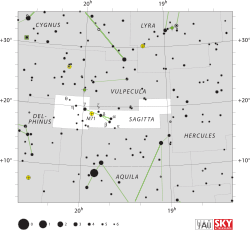Epsilon Sagittae

| |
| Observation data Epoch J2000.0 Equinox J2000.0 (ICRS) | |
|---|---|
| Constellation | Sagitta |
| Right ascension | 19h 37m 17.39375s[1] |
| Declination | +16° 27′ 46.0899″[1] |
| Apparent magnitude (V) | +5.67[2] |
| Characteristics | |
| Spectral type | G8 IIIvar[3] |
| U−B color index | +0.83[2] |
| B−V color index | +1.00[2] |
| Astrometry | |
| Radial velocity (Rv) | −34.5±1.2[4] km/s |
| Proper motion (μ) | RA: +17.25[1] mas/yr Dec.: +13.77[1] mas/yr |
| Parallax (π) | 6.79 ± 0.37[1] mas |
| Distance | 480 ± 30 ly (147 ± 8 pc) |
| Absolute magnitude (MV) | −0.33[3] |
| Details[5] | |
| Mass | 3.09 M☉ |
| Luminosity | 138[3] L☉ |
| Surface gravity (log g) | 2.44 cgs |
| Temperature | 4,978 K |
| Metallicity [Fe/H] | +0.03 dex |
| Rotational velocity (v sin i) | 3.2 km/s |
| Age | 331 Myr |
| Other designations | |
| Database references | |
| SIMBAD | data |
Epsilon Sagittae (ε Sagittae) is a solitary,[7] yellow-hued star in the northern constellation of Sagitta. With an apparent visual magnitude of +5.67,[2] it is faintly visible to the naked eye on a dark night. Based upon an annual parallax shift of 6.79 mas as seen from Earth,[1] it is located roughly 480 light years from the Sun. At that distance, the visual magnitude of the star is diminished by an extinction factor of 0.1 due to interstellar dust.[3]
This is an evolved, G-type giant star with a stellar classification of G8 IIIvar,[3] where the 'var' suffix indicates a variable spectral feature. The star is about 331 million years old with three times the mass of the Sun.[5] It is radiating 138[3] times the Sun's luminosity from its photosphere at an effective temperature of 4,978 K.[5] It has a magnitude 8.35 visual companion at an angular separation of 87.3 arc seconds along a position angle of 82°, as of 2013.[8]
References
- 1 2 3 4 5 6 van Leeuwen, F. (2007), "Validation of the new Hipparcos reduction", Astronomy and Astrophysics, 474 (2): 653–664, Bibcode:2007A&A...474..653V, arXiv:0708.1752
 , doi:10.1051/0004-6361:20078357.
, doi:10.1051/0004-6361:20078357. - 1 2 3 4 Argue, A. N. (1966), "UBV photometry of 550 F, G and K type stars", Monthly Notices of the Royal Astronomical Society, 133: 475–493, Bibcode:1966MNRAS.133..475A, doi:10.1093/mnras/133.4.475.
- 1 2 3 4 5 6 Takeda, Yoichi; et al. (August 2008), "Stellar Parameters and Elemental Abundances of Late-G Giants", Publications of the Astronomical Society of Japan, 60 (4): 781–802, Bibcode:2008PASJ...60..781T, arXiv:0805.2434
 , doi:10.1093/pasj/60.4.781.
, doi:10.1093/pasj/60.4.781. - ↑ Tremko, J.; et al. (October 2010), "Search for radial velocity variation in visual binary and multiple stars", Contributions of the Astronomical Observatory Skalnaté Pleso, 40 (2): 83–98, Bibcode:2010CoSka..40...83T.
- 1 2 3 Takeda, Yoichi; Tajitsu, Akito (2014), "Spectroscopic study on the beryllium abundances of red giant stars", Publications of the Astronomical Society of Japan, 66 (5): 91, Bibcode:2014PASJ...66...91T, arXiv:1406.7066
 , doi:10.1093/pasj/psu066.
, doi:10.1093/pasj/psu066. - ↑ "eps Sge". SIMBAD. Centre de données astronomiques de Strasbourg. Retrieved 2017-07-14.
- ↑ Eggleton, P. P.; Tokovinin, A. A. (September 2008), "A catalogue of multiplicity among bright stellar systems", Monthly Notices of the Royal Astronomical Society, 389 (2): 869–879, Bibcode:2008MNRAS.389..869E, arXiv:0806.2878
 , doi:10.1111/j.1365-2966.2008.13596.x.
, doi:10.1111/j.1365-2966.2008.13596.x. - ↑ Mason, B. D.; et al. (2014), The Washington Visual Double Star Catalog, Bibcode:2001AJ....122.3466M, doi:10.1086/323920.